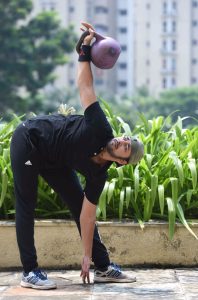If you are a personal trainer looking to add variety and excitement to your workouts, give these unique kettlebell exercises a go! These are guaranteed to challenge you and boost your or your clients’ fitness levels! Determine the sets and reps according to program and fitness level.
Give these six new kettlebell moves a shot!
Six Kettlebell Moves You Have To Try
- Kettlebell Bottoms Up

This exercise poses a unique challenge to the lifter. Here the kettlebell ends up exactly in a ‘bottoms up’ position. This lift increases your crush grip strength, enhances shoulder stability, and also trains the core.
You start progressing in this exercise by ‘cleaning’ the bell from the ground to the bottoms-up position. If you want to throw in a little more challenge you can try pressing up the weight overhead from the bottoms-up position.
Tip: Keep your eyes on the bell, and make sure to keep the elbows directly under the kettlebell. If the elbow moves, the bell will lose its stability.
Benefits: Develops strong wrists. Increase shoulder strength and stability and teaches the core to stabilize under unstable weight.
 Kettlebell Sots Press
Kettlebell Sots Press
Named after the famous Russian Weightlifting champion, Viktor Sots, the Sots press involves pressing the weight up from a squat position.
You start by cleaning the kettlebell and then sitting into a deep squat. From the squat position, you have to press the kettlebell up, locking out your shoulder and elbow joint.
Tip: Throughout the movement, try to keep your torso upright and steady your core. This lift requires a tremendous amount of core stability and shoulder mobility to execute. If you do not have the required mobility, it is advisable to work on it first until it is adequate, and then attempt this exercise.
Benefits: Builds great core stability and shoulder strength and mobility.
A KB windmill involves lifting the KB with one hand while the torso remains straight, but your hips and toes are turned 45 degrees away from the arm you are lifting with. From here on push your hips out as you lower your non-working shoulder between your legs, and reaching with the non-working arm towards the floor, in between your legs. The front leg at the knee can be slightly bent, but the rear leg should be as straight as possible.
Tip: While descending, turn your head look towards the kettlebell overhead to be aware of the bell’s position and not lose balance. Start slowly, respect your body’s flexibility, and work within your range of motion.
Benefits: Great hamstring specific drill to gain strength and flexibility in this muscle group. Works the core, and improves overhead lockout and stability.
- Kettlebell Floor Press
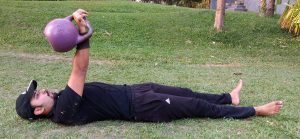
Done with one kettlebell
Most kettlebell exercises require lifting the bell overhead for press/push press and spending a lot of time in the vertical zone. The floor press is a great variety exercises where you are working your strength, but in the horizontal plane.
To execute, lie down on the floor, have the Kettlebell beside you and turn your body towards it grab it with both hands and then bring it over your chest returning to lie flat with back on the ground. From thereon, you push the weight straight up. The following repetitions allow your elbow and upper arm touch the floor and press the weight up again.
Tip: Keep your body stabilized throughout and as aligned as possible, legs straight on ground and non-working arm flat on the other side, squeeze your core, glutes and shoulder blades to control the weight
Benefits: The floor press works the triceps, shoulders, pectoral muscles, as well as the core muscles, as one must keep stable to move the weight of the floor.
- Cossack Squat to Kettlebell Press
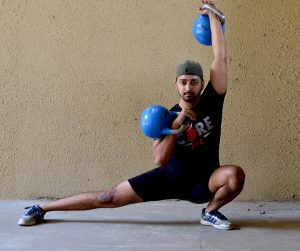
Use two kettlebells
This is a unique movement, where the athlete needs to move in two different directions: horizontally and vertically. The athlete starts by initiating a Cossack squat with 2 kettlebells in the rack position, and then as s/he is shifting to the one side in the Cossack squat, the athlete presses up one of the kettlebells.
Both movements take place simultaneously. What makes the movement even more fun and challenging is that it not only tests your lower body mobility but also tests your neuro-muscular coordination as well. You are effectively pressing and lunging laterally at the same time! Remember, to only attempt this with a light and manageable weight.
Tip: Make sure you have the required mobility to do a normal Cossack squat first, only then add kettlebells. Start light and take it slow.
Benefits: Apart from testing your lower body strength and mobility with added resistance, this movement helps to increase awareness and helps build unique skills!
- Outside-the-Legs Swings
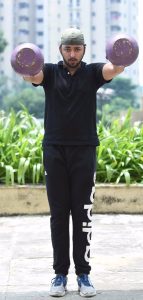
Done with two kettlebells
As the name suggests, this drill involves swinging two kettlebells outside your legs, unlike the traditional swings which is done by swinging the bell between the legs.
The swing is a great variety drill targeting the hamstrings, the trapezius muscles, as well as the grip. This exercise is a great alternative for people who find it difficult to swing two kettlebells between their legs.
Tip: Like traditional swings you push your hips out when the bells are behind you and lockout when its swinging in front of you. Remember do not bend from the torso, but from hips and knees.
Benefits: Works the hamstrings, traps, and the posterior chain muscles.
Keep Things Interesting
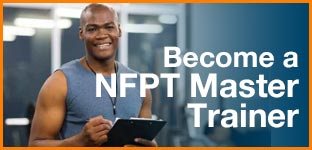 Whenever I train my clients or myself, I keep challenging the body and the mind with a lot variety drills in order to get better and sharper, physically and mentally. Adding 1-2 variety drills per week helps me to finish my workouts with a bang and changes things up a bit from the mundane system of training.
Whenever I train my clients or myself, I keep challenging the body and the mind with a lot variety drills in order to get better and sharper, physically and mentally. Adding 1-2 variety drills per week helps me to finish my workouts with a bang and changes things up a bit from the mundane system of training.
How do you add variety and new challenges to your own workouts and those of your clients?

Guest authors offer experience and educational insights based on their specific area of expertise. These authors are contributing writers for the NFPT blog because they have valuable information to share with NFPT-CPTs and the fitness community at-large. If you are interested in contributing to the NFPT blog as a guest, please send us a note expressing your interest and tell us how you can contribute valuable insights to our readers. We look forward to hearing from you! Send to editor@nfpt.com

